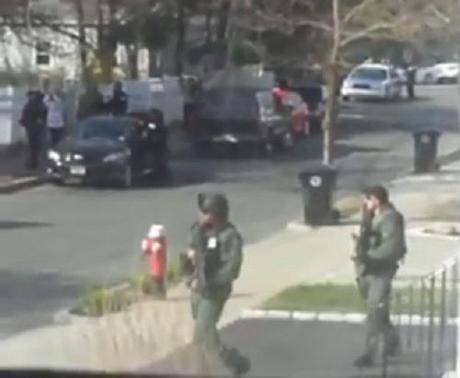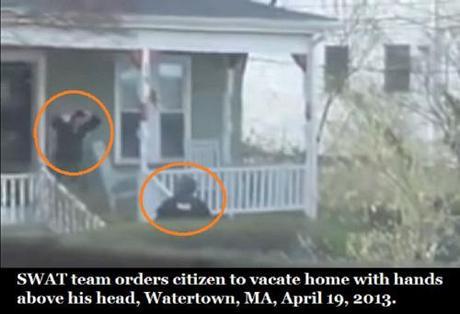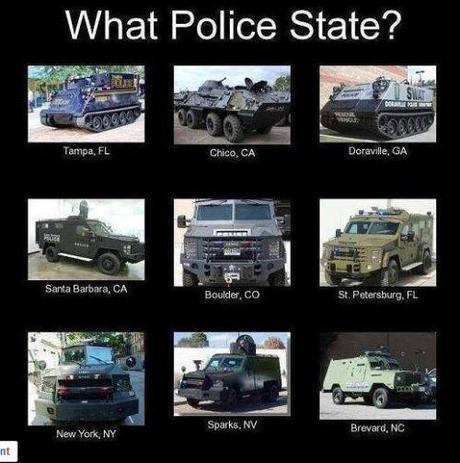In the six years of Obama’s presidency, America has become increasingly militarized — not our troops abroad, but right here at home — and transforming before our eyes into a police state. (See “Police State U.S.A.”)
40 civilian agencies of the federal government now have armed divisions. Those of us who are not low-information voters are familiar with the alarming purchases of guns, rifles, and lethal hollow-point bullets by the Department of Homeland Security and other agencies, including the Department of Education!
The Fourth Amendment to the United States Constitution states:
The right of the people to be secure in their persons, houses, papers, and effects, against unreasonable searches and seizures, shall not be violated, and no Warrants shall issue, but upon probable cause, supported by Oath or affirmation, and particularly describing the place to be searched, and the persons or things to be seized.
Increasingly, however, police across America are violating the 4th Amendment by storming into homes, armed to the teeth in military gear, under the pretext of apprehending some suspected criminal. (See “Obama regime supplies military-grade arms to police”)
The most egregious example took place on April 19, 2013.
During a manhunt in the Boston suburb of Watertown, MA, for Boston Marathon bombing suspect Dzhokhar Tsarnaev, heavily-armed SWAT police and federal agents spent the day storming people’s homes and performing illegal searches, ripping people from their homes at gunpoint, marching the residents out with their hands raised above their heads in submission, and then storming into their homes to perform warrantless searches. (See “Boston Bombing: Getting the sheeple used to the police state”)


Charles Hoskinson reports for the Washington Examiner that last Thursday, Nov. 13, 2014, reacting to images of heavily armed police amid the Ferguson racial protests, a House Armed Services subcommittee looked into the issue of the militarization of police.
“In light of these and other disturbing events around the country, it is incumbent on us to review this Department of Defense program,” said Rep. Niki Tsongas (D-Mass.), referring to Ferguson.
But Pentagon officials and representatives of national law enforcement groups told the committee that although the Defense Department is overhauling the program that gives surplus military equipment to local police departments, there is good reason to keep it going.
Alan Estevez (principal deputy undersecretary of defense for acquisition, logistics and technology) and Vice Adm. Mark Harnitchek (director of the Defense Logistics Agency) said that 96% of the equipment transferred under the program is non-lethal items such as commercial vehicles, office furniture and supplies, generators, tents, tarps, tool kits, first-aid kits, blankets, safety glasses and hand tools — not the small arms and armored vehicles such as the MRAPs used by troops in Afghanistan and Iraq.
___________
Translated, that means at least 4% of the equipment “transferred” to local police are LETHAL (see below). Don’t you feel better now? /sarc

Harnitchek said that the program does not include items that have only offensive military value, such as belt-fed machine guns. “None of those are authorized for transfer.” He said Pentagon officials have removed some items that were previously provided after determining they were not appropriate for police use, such as military helmets, body armor and camouflage uniforms currently used by U.S. troops.
“I don’t like seeing any of the police agencies in my state in military-style uniforms. I think that’s un-American,” responded Rep. Austin Scott (R-Ga).
But the program remains controversial, and lawmakers have been putting pressure on the Pentagon for further changes and stricter accountability of how the equipment is used. Some want the program eliminated outright, a proposal that drew pushback from representatives of national police groups.
1. Mark Lomax, executive director of the National Tactical Officers Association, said, “The 1033 program has provided the necessary equipment to protect our brave officers and provide security and effective response to our communities.”
2. Jim Bueermann, president of the Police Foundation and the retired chief of the Redlands, Calif., police department, said, “Completely eliminating it could have substantial impact on public safety and local budgets.” Bueermann proposed a number of reforms that would make the program more accountable to local communities, including:
- Public input and approval of a local governing body before police receive any surplus military equipment.
- Public disclosure of how and how often the equipment is to be used.
- Requiring police officers be trained on the proper use of the equipment.
Though the Pentagon requires police departments to demonstrate eligibility for transfers and to maintain control of inventory, the program as it is today does not include local oversight, and the Defense Department does not dictate the ways in which they are used by local police.
~Eowyn

